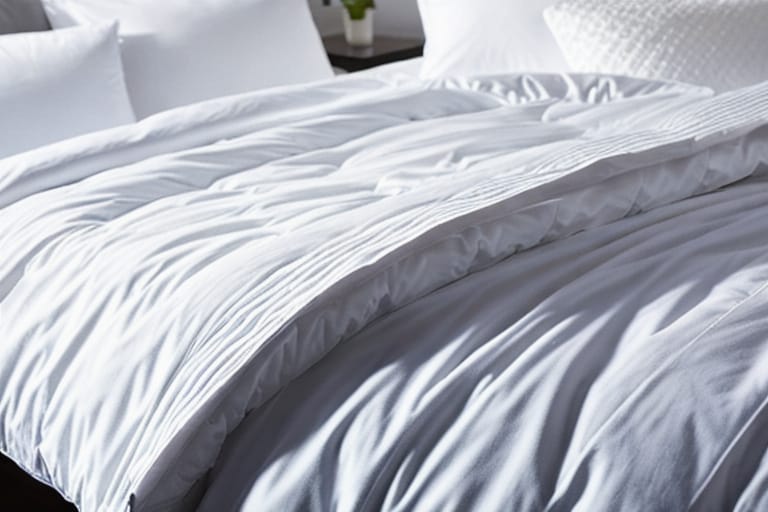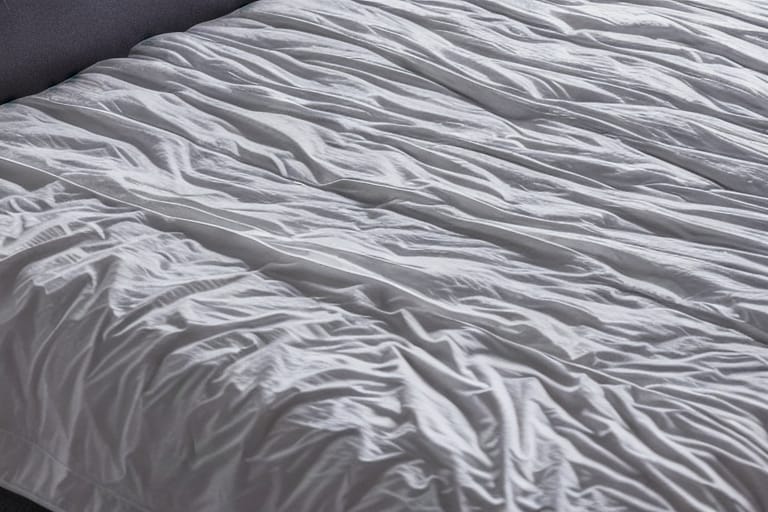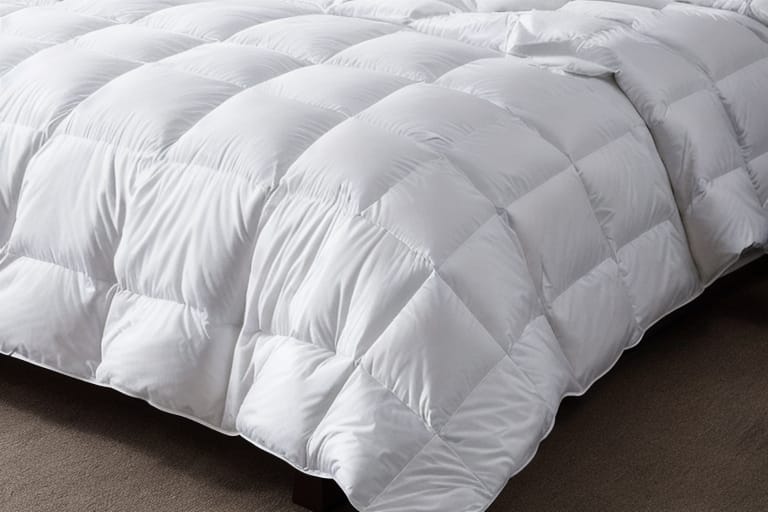Goose down comforters provides unbeatable softness, warmth, and comfort for your bed. But how exactly are these luxurious bedding essentials made? This beginner’s guide will walk you through the production process, from sourcing quality down to constructing the final product. You’ll learn about different types of goose down, hypoallergenic standards, thread counts, and more so you can find your perfect comforter.
What Is Goose Down?
Before diving into comforter construction, let’s look at what goose down actually is.
- Goose down refers to the fine, fluffy cluster of fibers located underneath the tougher exterior feathers of geese. This down filling provides excellent insulation to keep geese warm.
- For comforters, white goose down is considered the highest quality. It comes from mature geese who live in cold climates and need extra insulation. European white goose down is viewed as the best of the best.
- Goose down clusters trap air between filaments, creating resistance to heat transfer. This gives comforters made with goose down superior warmth and fluffiness compared to other fills.
- Down used in comforters comes from geese used in the food industry. No birds are harmed solely for their down.
Goose Down Characteristics and Types
- Goose down consists of a 3D cluster shape that creates loft and traps body heat. It’s also very soft and lightweight. These traits make it ideal for bedding.
- You’ll see terms like “fill power” (600-900) and “down percentage” (75-90%) used to rate quality:
- Fill power measures volume and insulation. Higher numbers are better.
- Down percentage indicates how much down versus feathers is in the fill. Higher is warmer.
- Popular types of goose down include:
- European white goose down – Very large clusters and high fill power for premium quality and warmth.
- Hungarian goose down – Dense, consistent white down known for resilience and durability.
- Canadian goose down – Medium to large clusters with decent fill power and affordability.
How Are Goose Down Comforters Made?
Constructing a high-quality down comforter takes skill and precision. We’ll walk through the step-by-step process next.
1. Sourcing the Down
Goosedown used in comforters is a byproduct of the food industry. No geese are harmed simply for their down. Top manufacturers follow animal welfare guidelines for any live plucking.
European white goose down is viewed as the gold standard due to large, resilient clusters that provide exceptional warmth and loft. Rigorous standards also emphasize ethical sourcing.
2. Cleaning and preparation
Raw down gets thoroughly washed to remove impurities. Advanced techniques like the German Aufbauverfahren method use air circulation for gentle agitation.
The down then goes through a drying process optimizing fluffiness. Finally, it gets sterilized using high heat to kill bacteria, mold and dust mites.
3. Fill power measurement
A sample of prepared down gets precisely measured for fill power, the number of cubic inches per ounce. This indicates insulation quality and loft.
- 600-650 fill power = Good
- 700-750 fill power = Better
- 800+ fill power = Best
High-end comforters use 800 fill power European white goose down or higher.
4. Construction
It takes precision design and specialized equipment to transform delicate down into a durable comforter.
1. Cutting: Laser cutters shape the outer shell fabric, usually 400+ thread count cotton sateen or Egyptian cotton.
2. Filling: Goose down gets weighed and evenly distributed into sections called baffles to prevent shifting.
3. Stitching: The shell layers get stitched together using techniques like baffle box or summer and winter diagonal patterns to secure fill.
4. Finishing: Edge piping gets added for a tidy finish. Then the comforters go through final quality checks before packaging.
5. Quality Assurance
Reputable manufacturers test finished comforters for:
- Fill distribution – Even down consistency across the surface
- Temperature rating – Warmth suitable for winter, summer or year-round use
- Durability – Stitch and fabric strength
- Hypoallergenic properties – Third-party certification for cleanliness
High-end comforters also get RDS certification verifying the down was ethically sourced.

Benefits of Goose Down Comforters
What makes goose down ideal for comforters versus other materials?
- Warmth – Down traps more body heat thanks to its 3D structure creating insulation. This makes it much warmer ounce for ounce than other materials.
- Light and fluffy – Down has exceptional loft and fluffiness, allowing air to circulate for added coziness.
- Breathability – The structure allows moisture to dissipate so you don’t get too hot while sleeping.
- Durability – With proper care, high-fill-power goose down maintains loft and insulation for many years.
- Compressibility – Down can be tightly packed yet springs back to full loft immediately. Easy storage!
For the ultimate in comfort, warmth and durability, goose down can’t be beat. Now let’s compare goose down to other common comforter materials.
Goose Down vs. Other Materials
How does goose down compare to other common comforter fills and fabrics?
Duck Down
- Goose vs duck down both come from waterfowl. But goose down clusters are larger with superior loft and durability.
- For budget bedding with decent quality, duck down is acceptable. But goose down offers better performance.
Synthetic Fill
- Synthetic fills like polyester are cheaper alternatives to down. But they lack breathability and longevity.
- Synthetics can be very affordable options. But they tend to flatten out over time, losing insulation value.
Feathers
- Feathers have quills that poke through fabric. Down has finer strands that rarely poke.
- Mixing a small percentage of feathers into down adds structure. But straight feathers lack warmth and softness.
While cheaper than down, these alternative fills compromise on key benefits like breathability, longevity and warmth. For best performance, goose down remains the top choice.
Caring for Your Goose Down Comforter
Follow these care instructions so your comforter stays clean and fluffy for years:
- Dry clean only – No machine washing to prevent damage to down clusters
- Low heat drying – Tumble dry on a delicate cycle with clean tennis balls
- Spot clean stains – Use a mild detergent and damp sponge
- Regular fluffing – Redistribute fill to prevent clumping
- Duvet cover – Protect with a lightweight cover for easy cleaning
With proper care, a high-quality goose down comforter can last over 20 years!
Innovations in Goose Down Bedding
While goose down itself remains relatively unchanged, new technologies are optimizing its performance:
- Nano-fiber shell fabrics – More breathable and durable than cotton
- Hypoallergenic washes – Reduce allergens for sensitive sleepers
- Baffle box stitching – Prevents fill shifting for consistent comfort
- Oversized designs – More warmth coverage without weight
Manufacturers also focus on responsibly sourcingmaterials through initiatives like the RDS certification standard. This emphasizes animal welfare and traceability from farm to finished product.
Which Climate Is Best For Goose Down?
One beauty of goose down is its year-round versatility:
Warm Climates
- Light, breathable comforters with 600-650 fill power work well to prevent overheating.
Cool Climates
- For extra winter coziness, choose 800+ fill power comforters. The higher the fill, the better the insulation.
Year-Round Use
- 700-750 fill power with a lightweight cotton shell balances warmth and breathability across seasons.
No matter your climate, goose down offers the ideal level of adjustable comfort thanks to its superior breathability.
Design and Customization Options
While function is most important, goose down comforters are also available in many decorative styles:
Colors
- White and ivory remain popular. But you can also find alternative shell colors like blue or gray.
Patterns
- Subtle stripes and checks offer understated flair. For modern looks, solid colors remain prevalent.
Monogramming
- Add embroidery with your name or initials for a customized, luxury look. This also helps identify bedding at hotels.
Shams
- For full bed coordination, opt for a comforter with matching pillow shams.

Conclusion: Why Choose Goose Down?
In conclusion, goose-down comforters provide incomparable softness, breathability and warmth for a cozy night’s sleep. Thanks to smart construction using baffle boxes and quality stitching, that comfort lasts for years.
While synthetics and feathers can save money upfront, they compromise on longevity and performance. For your best night’s sleep across seasons, always look for ethically sourced goose down with a high fill power of 700 or above. Match this with a 400+ thread count cotton shell for optimal softness, breathability and temperature regulation.
With the proper care, your goose-down comforter will keep you comfortable for over 20 years! So don’t settle for less when picking out bedding essentials for your home. Insist on responsible, high-quality goose down for comfort that stands the test of time.
Frequently Asked Questions
What is the best type of goose down for comforters?
The white European goose down is considered the highest quality, with the largest, most resilient down clusters that provide exceptional warmth and loft. This premium goose down has the highest fill power ratings around 800-900.
How do I know if a comforter contains quality goose down?
Check the manufacturer’s specifications for the fill power and down percentage. Reputable brands will list these details along with certifications like RDS that verify responsible sourcing practices and animal welfare guidelines were followed during production. High-end comforters have 75% or higher down content with fill powers from 600-900.
Why is goose down better than duck down or synthetic alternative fills?
The large, fluffy clusters of goose down do a superior job trapping body heat thanks to their 3D structure which creates excellent insulation. The nature of goose down also allows better breathability and durability over time. Alternative fills like duck down or synthetics flatten out more quickly and lack the resilience and longevity of premium goose down.
How can I make my goose down comforter last longer?
Follow the care instructions properly, including dry clean only, low heat tumble drying with tennis balls, spot cleaning stains quickly, and using a duvet cover. Routinely fluffing the down filling to redistribute and break up any clumps will also improve longevity. With proper care, a high-quality goose down comforter can last over 20 years.
What thread count should I look for in the shell fabric?
Look for comforters with a shell made from tightly-woven Egyptian cotton or other type of cotton sateen. These smooth, durable fabrics prevent the fine down strands from poking through. Aim for a thread count of 400 or higher for optimal softness, breathability and longevity.
Can I use a goose down comforter year-round in any climate?
One major benefit of goose down is its versatility for year-round use. In warm climates, choose a lightweight fill around 600 fill power. For cooler regions, go with 800+ fill power for outstanding insulation. The breathability of the down makes it more flexible across seasons than other fills like synthetics. Ultimately the higher the fill power, the better it performs in cold and hot temperatures alike.








